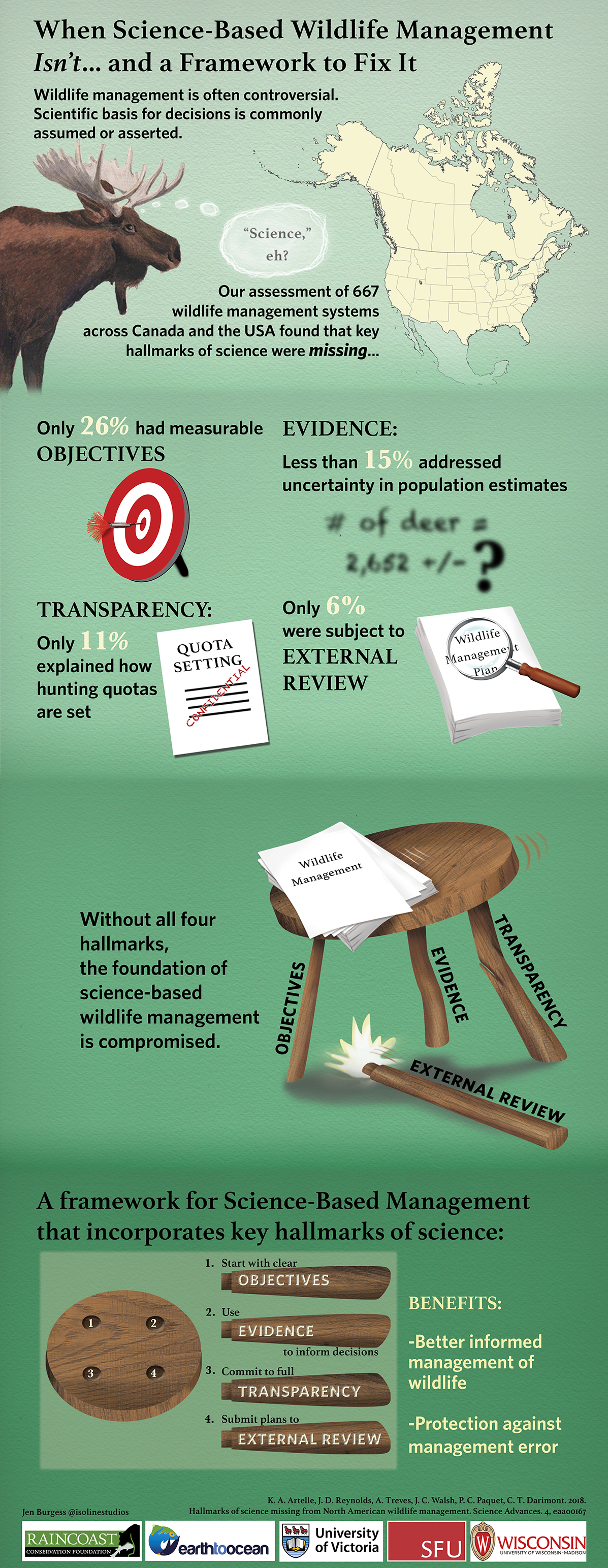Human-carnivore coexistence Research
Hover over blue text to see an abstract of each article
>Treves_Santiago-Ávila. 2020.Myths and assumptions about human-wildlife conflict and coexistence. Conservation Biology 10.1111/cobi.13472
Treves 2020. Elephants and pandemics. Animal Sentience 28(20). URL
Treves, A., Krofel M, Ohrens O and van Eeden 2019 Predator Control Needs a Standard of Unbiased Randomized Experiments With Cross-Over Design. Frontiers in Ecology and Evolution 7:402-413. doi: 10.3389/fevo.2019.00462/
Quick link to science dealing directly with wolves
(read the abstracts without downloading a thing!) or Back to main wolf page.
Trophy hunting: Insufficient evidence. Letter in Science 366(6464):435.
Scientific ethics and the illusion of naïve objectivity. Guest editorial in Frontiers in Ecology and the Environment 7:1.
Ohrens, O., Bonacic, C., Treves, A. 2019.
Non-lethal defense of livestock against predators: Flashing lights deter puma attacks in Chile. Frontiers in Ecology and the Environment 17(1):1-7.
Gold standard (also platinum and silver standards!) experiments are explained at our new web page about standards of evidence in animal research.
Treves, A., Santiago-Ávila, F., Lynn, W.S. (equal co-authors) 2018.
Just Preservation. Biological Conservation 229: 134-141.
van Eeden, L., Eklund, A., Miller, J.R.B.,...17 co-authors... Treves, A. (equal first authors) 2018.
Carnivore conservation needs evidence-based livestock protection. PLOS Biology https://doi.org/10.1371/journal.pbio.2005577
Treves, A., Artelle, K.A., Paquet, P.C. 2018.
Differentiating between regulations and hunting as conservation interventions. Conservation Biology (Accepted articles are posted online prior to type-setting and publication in print.).
Ohrens, O., Santiago-Avila, F.J., Treves, A.2019.
The challenges of preventing real and perceived threats to livestock. In Human-Wildlife Interactions: Turning Conflict into Coexistence, eds. B. Frank, S. Marchini, J. Glikman, Cambridge University Press: Cambridge.
Hallmarks of science missing from North American wildlife hunting and trapping plans.

Artelle, K.A., Reynolds, J.D., Treves, A. Walsh, J.C., Paquet, P.C., Darimont, C.T. 2018.
Hallmarks of science missing from North American wildlife management. Science Advances. 2018.
short video explaining the findings
Lopez-Bao, J.V., Chapron, G., Treves, A. 2017.
The Achilles heel of participatory conservation. Biological Conservation 212: 139-143.
Summary and FAQs (4 Mb)
Darimont, C.T., Paquet, P., Treves, A., Artelle, K.A., Chapron, G. 2018.
Political populations of large carnivores.Conservation Biology 32(3):747-749.
Carter, N. H., J. López-Bao, J. Bruskotter, M. Gore, G. Chapron, A. Johnson, Y. Epstein, M. Shrestha, J. Frank, O. Ohrens and A. Treves2017.
A conceptual framework for understanding illegal killing of large carnivores. Ambio 46(3): 251–264.
Treves, A., Chapron, G., Lopez-Bao, J.V., Shoemaker, S., Goeckner, A., Bruskotter, J.T. 2015.
Predators and the Public Trust. Biological Reviews doi: 10.1111/brv.12227
Take-home messages: Democratic governments have a duty under the public trust to preserve wildlife for current and future generations without substantial impairment. Trust duties are fiduciary duties meaning transparent accounting and prudence at a minimum. Few trustees of predators have lived up these legal and ethical standards.
Krofel, M., Treves, A., López-Bao, J.V.
Hunted carnivores at outsized risk. Science. 350: 6260.
Take-home message: Large carnivores are particularly vulnerable to human-induced mortality and we still now little about how they respond..
Take-home messages: Tolerance for predators did not reflect individual economic losses but rather social identity and peer group complaints. Intolerance for wolves and inclinations to poach wolves rose when the government culled wolves. Tolerance for wolves did not increase when wolf hunting and trapping season was implemented.
Ohrens, O., Treves, A., Bonacic, C. 2015.
Relationship between rural depopulation and puma-human conflict in the
high Andes of Chile. Environmental Conservation doi:10.1017/S0376892915000259.
Voyles, Z., Treves, A., Macfarland, D. 2015.
Spatiotemporal effects of nuisance black bear management actions in Wisconsin. Ursus 26: 11-20.
Carnivore Management. pp. 83-90 in B.S. Steel editor. Science and Politics: An A-To-Z Guide to Issues and Controversies. CQ Press, Thousand Oaks, CA, USA.
. Schloegel, C., Jones, T., Zug, B., Achig, L., Treves, A. 2011.Don Oso Program Develops Participatory Monitoring Protocol for Andean Bears in Southern Sangay National Park, Ecuador. International Bear News 20(2): 23-25.
Treves, A., Kapp, K.J., Macfarland, D.M. 2010.
American black bear nuisance complaints and hunter take. Ursus 21(1):30-42.
Treves, A., Mwima, P., Plumptre, A.J., Isoke, S. 2010.
Camera-trapping forest-woodland wildlife of western Uganda reveals how gregariousness biases estimates of relative abundance and distribution. Biological Conservation. 143: 521-528.
Treves, A. 2009.
Hunting for large carnivore conservation. Journal of Applied Ecology 46: 1350-1356.
Treves, A., Wallace, R.B., White, S. 2009.
Participatory planning of interventions to mitigate human-wildlife conflicts. Conservation Biology 2009, 23(6): 1577-1587.
Treves, A., Plumptre, A.J., Hunter, L.T.B., Ziwa, J. 2009.
Identifying a potential lion Panthera leo stronghold in Queen Elizabeth National Park, Uganda, and Parc National des Virunga, Democratic Republic of Congo. Oryx 43(1): 60-66. (Copyright Cambridge University Press http://journals.cambridge.org/repo_A35fUJfB
) and see the Erratum
we published as a correction to this manuscript.
Treves, A. 2008.
Human-wildlife conflicts around protected areas. In Wildlife and Society: The Science of Human Dimensions. Manfredo, M., Vaske, J. J., Brown, P., Decker, D.J., Duke, E.A. eds. Island press, Washington, DC.
Treves, A., Palmqvist, P. 2007.
Reconstructing hominin interactions with mammalian carnivores (6.0 - 1.8 Ma) in Primate Anti-Predator Strategies. K. A. I. Nekaris, and S. L. Gursky, eds. Springer, New York.
Treves, A., Wallace, R.B., Naughton-Treves, L., Morales, A. 2006.
Co-managing human-wildlife conflicts: A review. Human Dimensions of Wildlife 11(6):1-14.
Or you can read the Policy Brief.
Naughton-Treves, L., Treves, A. 2005.
Socioecological factors shaping local tolerance of crop loss to wildlife in Africa. People and Wildlife, Conflict or Coexistence? Woodroffe, R., Thirgood, S., Rabinowitz, A. eds. Cambridge Univ. Press, Cambridge, UK. pp. 253-277.
Treves, A., Karanth, K.U. 2003.
Human-carnivore conflict and perspectives on carnivore management worldwide. Conservation Biology 17(6): 1491-1499.
Naughton-Treves, L., Mena, J.L., Treves, A., Alvarez, N., Radeloff, V.C. 2003.
Wildlife survival beyond park boundaries: The impact of swidden agriculture and hunting on mammals in Tambopata, Peru. Conservation Biology 17(4): 1106-1117.
Treves, A., Naughton-Treves, L. 1999.
Risk and opportunity for humans coexisting with large carnivores. Journal of Human Evolution 36: 275-282.